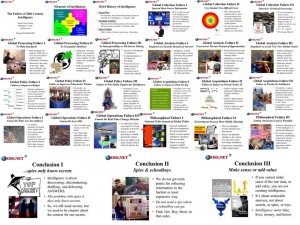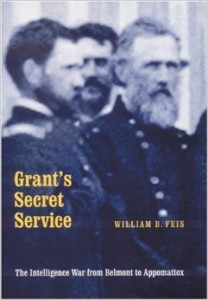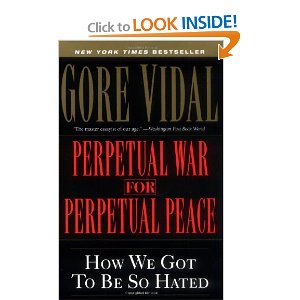
BRIEFING: 2002 Steele Failure of 20th Century Intelligence
Continue reading “2002 FAILURE of 20th Century Intelligence”

BRIEFING: 2002 Steele Failure of 20th Century Intelligence
Continue reading “2002 FAILURE of 20th Century Intelligence”

William B. Feis
4.0 out of 5 stars Well-Intentioned, Terrible Maps and No Timelines, May 28, 2002
I do not regret taking the time to read this book, and it is a well-intentioned worthy effort–however, given a new choice, I would probably go with the alternative, by an intelligence professional, “The Secret War for the Union: The Untold Story of Military Intelligence in the Civil War.”
I give the author, not an intelligence professional, high marks for the research, the story-telling, and the consistent themes. I give the editor and publisher low marks for the terrible maps (many seem to have lost their unit location markings and other key annotations) and the lack of tables showing “who knew what when…”
Three themes stayed with me as I put the book down:
1) A great deal can be accomplished in terms of intelligence with even a very small number of people–as few as 1-2 on staff, 3-5 behind the lines. We in America have substituted billions for technology and a cast of close to 100,000, for rather poor intelligence and counterintelligence.
2) Maps, especially “information maps,” are worth their weight in gold. I was reminded by this book that intelligence has in the past been an off-shoot of topographical engineering and map making, and do believe that we must restore the “hard-wired” connection between geospatial information and the “data” that our human, imagery, and signals professionals seek out.
3) Deserters, prisoners, and legal travelers are a gold mine of information and must, must, must be systematically exploited. No matter the degree to which they may offer up untruths and deceptions, the bottom line is that any commander who fails to plan for the systematic exploitation of these human resources, and to do so in a timely fashion, is derelict in their duty. As I recall, we do not yet have a proper table of organization or equipment in the U.S. force inventory for handling such individuals–the worst battalion, or the over-burdened military police, or some kludge collection of reservists, seems to end up being the solution each time. This dereliction is even more costly in “low intensity” environments.
I will not make too much of it, but I was especially pleased to see how much of Grant's intelligence came from enemy newspapers.
The author seeks to make much–perhaps too much–of how Grant did not allow himself to be immobilized by a lack of intelligence, substituting initiative when intelligence was lacking, but I for one don't buy it. What I see in the book is a substantive appreciation by the General Commanding of the role of intelligence, however poorly manned or funded, and that makes all the difference.


Gore Vidal
5.0 out of 5 stars You Get the Government You Deserve…., May 28, 2002
This book should be read in conjunction with Greg Palast's The Best Democracy Money Can Buy Vidal's book should be subtitled “you get the government you deserve.”
I cannot think of a book that has depressed me more. There are three underlying issues that make this book vitally important to anyone who cares to claim the title of “citizen:”
1) Citizens need to understand what their government is doing in the name of America, to the rest of the world. “Ignorance is not an excuse.” All of the other books I have reviewed (“see more about me” should really say “see my other reviews”) are designed to help citizens evaluate and then vote wisely in relation to how our elected representatives are handling national security affairs–really, really badly.
Continue reading “Review: Perpetual War for Perpetual Peace – How We Got to Be So Hated”
It is always a shame when a really great book is badly marketed and consequently does not reach as many professionals and citizens as it should. This is such a book.
What the blurbs don't tell you, such as they are, is that the author was one of the true pioneers in the world of open source intelligence (creating useful actionable intelligence using only legal and ethical sources and methods). His brilliant efforts in the early 1990's were easily a decade ahead of where the Foreign Broadcast Information Service (FBIS) is today–using a wide variety of Latin American newspapers and lots of brainpower, he was able to create tactical intelligence that contributed significantly to the success of operational missions by the U.S. Southern Command and the Drug Enforcement Administration, leading the destruction of cocaine laboratories, the interdiction of aircraft, and the arrest of key people in the transnational criminal structure.
This book is an essential reference for any agency or command library concerned with asymmetric warfare, unconventional threats, and non-traditional methods of providing intelligence support to those responsible for dealing with anything other than traditional war. The sources and methods that the author discusses are especially pertinent to the study of terrorism, proliferation, transnational crime, cross-national toxic dumping, and other sub-state and non-state threats.
This book is gripping. I could not put it down. It is one of the most serious personal accounts I have ever read where the vivid realities of intelligence, ignorance, and policy come together. The author excells at painting the details in context, and his many specific portraits of key individuals and situations are superior.
This book is relevant to today's war on terrorism. Many of the same issues prevail–rather than enumerate them, I will give this book my very highest mark, and simply say that you cannot understand intelligence, or the intelligence-policy relationship, without having absorbed all this author has to say.
He's hit it out of the park. Every voter who wonders what it will take to hold politicians accountable for “due diligence” in decision-making, needs to read this book.

I hope this is the last of the theoretical volumes. While it has some operationally-oriented contributions, one of the best being by Phil Williams on Transnational Criminal Networks, it is too theoretical overall, and much too US-centric. There are French, Nordic, and Singaporean, and Australian authorities, to mention just a few, that the editors must now make an effort to bring into a larger dialog. At the same time, it is now vital that we get on with much deeper study and discussion of the actual networks and specific practices–we must do much more in documenting the “order of battle” for netwar. One article, for example, lists a sample of Arabic web sites but goes no further–I would have liked to see some discussion of the 396 terrorist, insurgent, and opposition web sites, including the “Muslim Hackers” who asked for a clerical ruling on whether the Koran encouraged hacking as a means of war (it does, according to the same people that support bin Laden's views), and I would like to see much more integration with the investigative efforts of both law enforcement authorities and private sector security and fraud authorities. I am especially disappointed that all of these authorities appear to be largely oblivious to or at least not making substantive reference to the ten-year-long track record compiled by Winn Schartau and his InfoWarCon speakers and web site, an event that is arguably the only serious international venue for addressing these issues in a serious manner, with a commensurately valuable web site.
There is one other major gap in this book's approach to networks and netwars. With the exception of Paul de Armond's article on netwar against the World Trade Organization, there are no references to intelligence failures and intelligence requirements vis a vis this threat domain. The editors and authors need to establish intelligence concepts and doctrine for this threat.
This book represents the very best that DoD money can fund in isolation, and therein lies the problem. What few taxpayer funds are spent by DoD in addressing such important matters and not being spent wisely because there is no serious commitment to creating a data warehouse of all studies related to networks and netwar; there is no commitment to accessing and understanding the considerable lessons learned outside the somewhat nepotistic DoD network of standard experts; and there seems to be no commitment to creating a center of excellence that can nurture *public* understanding and new *public* standards for protecting both our critical infrastructure and the vital data that circulates on that infrastructure.
The editors and the authors are of the very highest caliber. They are also operating in a vacuum. I for one would like to see them get serious funding, to include the establishment of a public international center of excellence on netwar, with branch offices in London and Singapore.
We are losing the Third World War, between governments and gangs, in part because the military-industrial-congressional complex continues to define security in terms of very expensive mobility and weapons systems–communications, computing, and intelligence are an afterthought, and the authors are quite correct in the aggregate when they suggest that we are our own worst enemy in failing to redirect substantial funds toward cyber-war and cyber-peace. The editors and authors could be very helpful if they address in their next volume, both an intelligence order of battle against which capabilities might be created; and specific proposals for establishing international, national, and state & local capabilities. What should they be, what will it cost, who should manage them? “It ain't real until its the budget.” The authors are gracious to a fault, but it is clear from their work in the aggregate that they share a concern with our lack of preparedness for a 9-11 level of effort against our financial, transportation, power, and communications networks. They merit the greatest of respect and a full hearing from the public.

At a technical level, the author provides some really excellent real-world, real-war annecdotes about situations where clandestine reporting from trusted operations officers has not been accepted by their own superiors in the absence of technical confirmation (imagery or signals). As he says, in the middle of a major artillery battle and break-out of insurgent elements, screaming over the secure phone, “its the middle of night here”. We've all known since at least the 1970's that the technical intelligence side of things has been crushing human sensibility, both operational and analytical, but this book really brings the problems into the public eye in a compelling and useful manner.
At another level, the author uses his own investigation for murder (he was completely cleared, it was a set-up) by the Federal Bureau of Investigation, and at one point by the Secret Service, to shed new light on the complete break-down of internal security processes within the CIA. At its lowest point, he is pressured by DO management with a psychological evaluation to determine his fitness for duty–shades of Stalinism! I know this technique, of declaring officers unfit for duty based on psychological hatchet jobs, to be a common practice over the past two decades, and when Britt Snider was appointed Inspector General at CIA, I told him this was a “smoking gun” in the 7th floor closet. That it remains a practice today is grounds for evaluating the entire management culture at CIA.
There is a fourth story in the book, a truly interesting account of how big energy companies, their “ambassadors” serving as Presidential appointees within the National Security Council, and corrupt foreign elements, all come together. In this the spies are not central, so I leave it as a sidenote.
In my capacity as a reviewer of most intelligence-related books within these offerings, I want to make it clear to potential buyers of this book that the author is not alone. His is the best, most detailed, and most current accounting of the decrepit dysfunctionality of the clandestine service (as I put it in my own book's second edition), but I would refer the reader to two other books in particular: David Corn's “Blond Ghost: Ted Shackley and the CIA's Crusades”–its most memorable quote, on covert action in Laos, being “We spent a lot of money and got a lot of people killed, and we didn't get much for it.”–and Evan Thomas' “The Very Best Men–Four Who Dared: The Early Years of the CIA”–its best quote: “Patriotic, decent, well-meaning, they were also uniquely unsuited to the grubby, necessarily devious world of intelligence.” There are many other books, including twelve (12!) focused on reform and recommended by the Council on Intelligence.